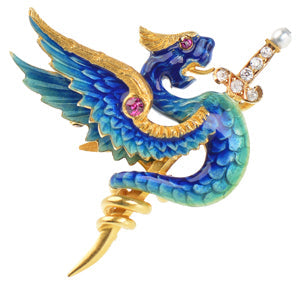
Around the turn of the 20th century Newark, New Jersey was quickly rising as the center of America's jewelry creation and production. One of the core members was the Riker Brothers firm that helped fuel this great expansion.
As an integral member of this cabal, Riker Bros. was one of the few Art Nouveau era houses to employ plique-à-jour enamels as well as create a full line of platinum and gold jewelry.
Having achieved a reputation for its dragon (sometimes referred to as griffin) motif antique brooches, Riker Brothers offered these and similar adornments in a variety of sizes and manifestations dating from circa 1890-1900. Using bright, polychrome (multi-colored) enamels, usually 14k yellow gold, textured surfaces and exquisite designs, these 19th and 20th century vintage brooches and jewels have garnered a host of fans and collectors and are highly sought after today.

Sometimes the designs focused on the surface patterns of the gold as in this above example rather than on enamel and color. Studded with rubies and diamonds, its surface exudes a sheen and look the often mirrors some of the French jewelry of the times.
These motifs were created in three sizes ranging from about 1 inch upward to 2 inches or more. The dragon usually faced right, and has a sword behind it in a diagonal orientation. Its tail wraps around the sword end. Sometimes small precious jewels were used as accents ranging from diamonds, to rubies, emeralds, pearls and others.
Other companies took up the dragon popularity of the Art Nouveau movement. Versions by Krementz and other American makers were created but these Riker iconic examples remain a classic.
No mention of Riker can be complete without a quick reference to their sculptural antique bangle bracelets. Usually these were slip on, oval in shape and often studded with precious and semi precious gems. Other flower and insect brooches were creates as many other types of fine jewelry.
The Newark Museum features a spectacular collection of Newark makers' jewelry. Learn more about their collection.
Riker Brothers began in 1846 as Riker, Tay & Searing and underwent a number of partnerships and changes. Riker Brothers was active from 1892-1943.
One of the Riker hallmarks is shown in the photograph below. It features a curved scimitar symbol with the "R" above it and often is accompanied by the 14k mark.

Visit here to view other types of enamel jewelry!
Credits: Dorothy T. Rainwater, American Jewelry Manufacturers, Schiffer, 1988.
Dietz, Joselit, Smead & Zapata, The Newark Museum, The Glitter & The Gold, Spectrum Press, 1997.